|
WC vs. History: Leyte Gulf, Are You Sirius?
The Battle of Sirius, a pair of opposing carrier strikes, was the first major engagement of the Earth Defense Campaign, following days of Confederation withdrawals and the total destruction of several human colony worlds. Confederation strike pilots heading into battle at Sirius were more hopeful than at any other time in the campaign: despite the apparent long odds, no one had yet engaged a Hakaga directly. Little was known about the carriers' defensive capacities and it was still believed that a successful strike could disable or destroy the behemoths.
Admiral Tolwyn held nothing back, opening the battle with a massive combined strike consisting of the balance of his offensive forces. Straight victory at Sirius seemed unlikely, but the thought of abandoning two of the Confederation's most developed worlds and largest population centers was equally unthinkable. The Third Fleet needed to bloody Thrakhath at Sirius or die trying, else the war would be lost before the Kilrathi even arrived at Earth. The Confederation strike force consisted of two forces aimed at two Kilrathi carrier formations. The first, 250 craft, six Broadsword squadrons and four corvettes, would strike at three Hakagas. The other, 230 strike craft, targeted another fleet element which included older style ships.
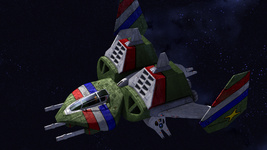 Many of the Confederation's precious Broadsword bombers were expended at Sirius.
Many of the Confederation's precious Broadsword bombers were expended at Sirius.
Losses were immediate. The fighter combat was preceded by a volley of Kilrathi antimatter area suppression missiles, which crippled Terran formations and destroyed dozens of bombers and their escorts. Kilrah's finest pilots attacked as soon as the explosions had cleared. The first strike divided their three targets equally, with thirty Broadswords assigned to each carrier. One group never even made it close enough to launch torpedoes. The other two scored hits, but neither brought down a Hakaga. In one instance, fifteen bombers survived to launch their torpedoes and four hit their mark. The carrier suffered damage, but never lost internal power. With the scattered survivors of the strike force in retreat, not one of the supercarriers had been destroyed.
The problem was the design of the Hakagas themselves, which had been built to resist a traditional strike. Even lucky hits from a desperate force would not be capable of sinking the massive warships. Internal bulkheads were double-layered, dividing the ships into independent components that could fight on regardless of damage to each other. The ships had been designed specifically to absorb torpedo hits, with multiple belts of armor protecting command decks and storage areas. Even the engines were hidden deep within the hull, with lengthy exhaust ports leading outwards to space.
 Heavily armored Hakagas were nearly invulnerable to traditional torpedo strikes.
Heavily armored Hakagas were nearly invulnerable to traditional torpedo strikes.
The results of the battle were disastrous. Thrakhath immediately responded with a strike of his own, which destroyed TCS Verdun and TCS Moskva. Of 480 strike craft sent after the Hakagas, only 220 would fly again. Only a quarter of the Broadsword bombers had survived. Of those ships, only 49 strike craft were ready for a second strike. With a second, heavier Kilrathi attack already reaching the Confederation fleet, Tolwyn ordered the withdraw. Sirius was lost.
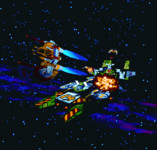 Thrakhath's strike force sank half the Confederation's carrier fleet and damaged a third ship.
Thrakhath's strike force sank half the Confederation's carrier fleet and damaged a third ship.
~0800 hours 24 October 1944. Philippine Islands. American search planes locate Admiral Takeo Kurita’s Center Force steaming through the Sibuyan Sea. American planes from the USS Enterprise are the first to attack the mighty ships of Center Force. The Battle of Leyte Gulf has been joined.
The funny thing about the Battle of Leyte Gulf is that no fighting actually took place in the Gulf itself. It’s also not one battle. It was four major engagements, and several smaller actions, fought over the course of four days off the eastern side of the Philippines. By certain criteria the battle is the largest in history. It is certainly largest in terms of fighting area and tonnage sunk.
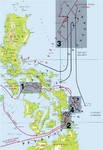
The four major battle areas are all outside of the main American landing area at Leyte Gulf.
Both Japanese and American naval strategy for the Pacific War envisioned a climatic naval battle occurring somewhere in a triangular area with its points of the triangle resting on Japan, the Marianas, and the Philippines. Two large scale naval battles did take place in that triangular area. At first they were called the First and Second Battles of the Philippine Sea, however later they became the Battle of the Philippine Sea (aka “The Great Marianas Turkey Shoot”) and the Battle of Leyte Gulf. During the Battle of the Philippine Sea the rebuilt squadrons of Japanese naval aviation were eradicated by American fighters and anti-aircraft fire. The Battle of Leyte Gulf saw the destruction of a large number of Japanese capital ships and the elimination of the Imperial Navy as a fighting force.
The Terran-Kilrathi War has one comparable multiple battle campaign: the Earth Defense Campaign that culminated in the Battle of Earth. For this first update on the Battle of Leyte Gulf we look at the first of the major Leyte Gulf battles, the Battle of the Sibuyan Sea and for the Earth Defense Campaign, the Battle of Sirius.
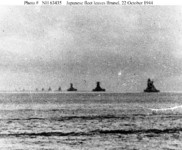
Japanese Center Force steaming out of Brunei
The squadrons of USS Enterprise (CV-6) were the first to spot and attack Admiral Kurita’s Center Force early on the morning of the 24th. This was the start of the morning long air-sea Battle of the Sibuyan Sea. The Japanese Center Force had already suffered important losses on the previous day as the force had made its way through the Palawan Passage. Two American submarines, the Dace and Darter, sank two cruisers, including Kurita’s flagship, Atago, and forced a third to turn back to Brunei.
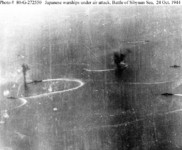
The Center Force under attack by American aircraft.
Throughout the morning of the next day, 24 October, the carrier task forces of Admiral Halsey’s Third Fleet conducted 259 sorties against the Japanese Center Force. The Japanese battleship Musashi, sistership to the great Yamato, took the brunt of the American airstrikes. During three large raids that morning, the Japanese battleship took an astounding 17 bombs and 19 torpedoes. She went down hours later, at 1936, taking half her crew with her.
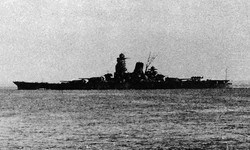
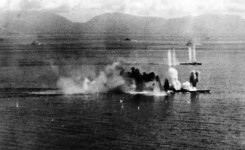 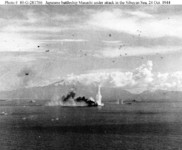
The battleship Musashi under way and then shown under attack in the Sibuyan Sea.
The American forces did not go unscathed on 24 October either. Air strikes from Japanese aircraft landbased on the Philippines attacked Task Force 38.3. The USS Princeton (CVL-23) was hit by a 551 lbs bomb at 0938 hours. The bomb started a large fire in the hangar deck that was eventually brought towards control, however at 1523 hours there was a massive explosion. The aft bomb stowage had exploded and fatally crippled the ship.
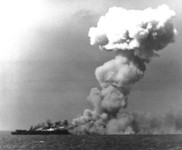 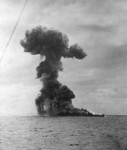
USS Princeton shortly after the bomb hit and then after the explosion later on.
Despite heroic efforts by the crew to save the ship, she had to be abandoned and scuttled by torpedoes at 1750 hours. USS Princeton was the first American carrier lost since the USS Hornet (CV-8) was lost two years earlier on October 26, 1942 during the Battle of the Santa Cruz Islands. It was the fifth and last aircraft carrier lost by the United States during the Pacific War.
| 
